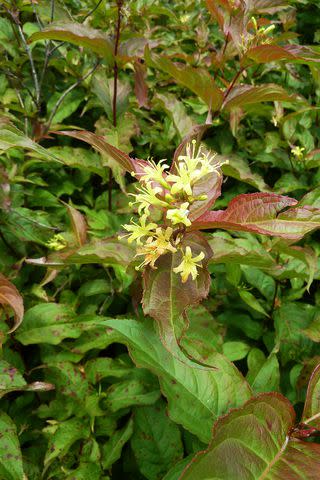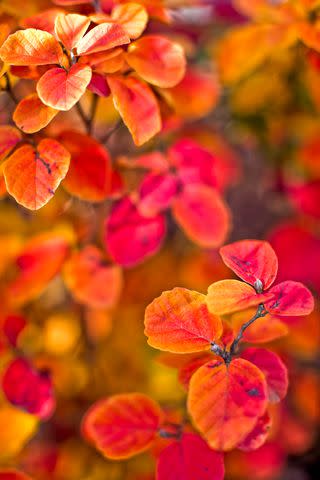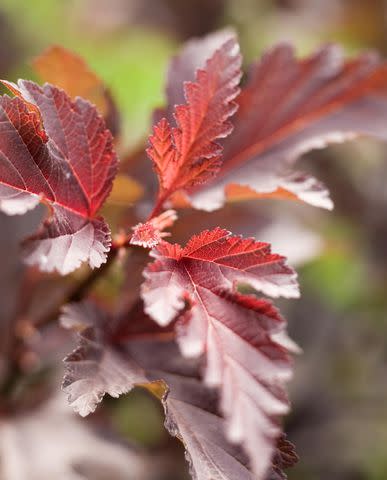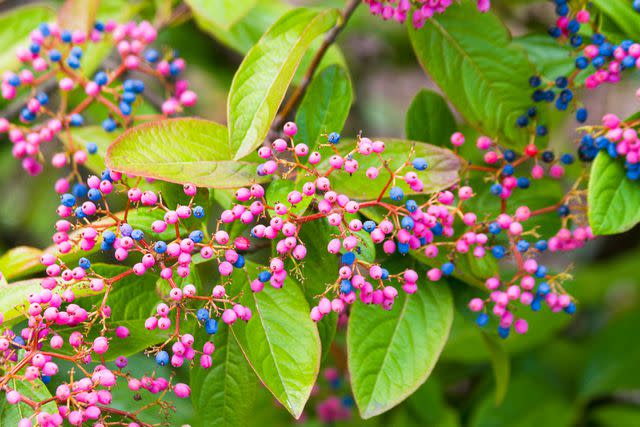What to Plant Instead of Invasive Burning Bush
These alternatives will attract birds to your landscape for shelter and food without harming the environment.

ValaGrenier / Getty Images
Although burning bush (Euonymous alatus) is a popular shrub for adding brilliant fall color to our landscapes, it has escaped into natural areas where it pushes out native plants. Birds and other animals spread the seeds around after feeding on the small reddish-purple fruit in gardens. Burning bush has become such a problem in certain areas of the country that it’s banned for sale in states like Massachusetts and Minnesota.
The best way to keep burning bush under control is to avoid planting it at all. Instead, consider planting something from this list of attractive non-invasive alternatives. Some are native plants that bring additional reasons to use beyond their beauty and their polite interaction with the greater environment. They attract birds and butterflies by offering food and shelter. They all have beautiful fall color.
:
Dwarf Bush Honeysuckle

Denny Schrock
Dwarf bush honeysuckle’s yellow flowers bloom from June through August on a mound-shaped shrub. The green leaves can have a reddish tinge during the spring and summer and turn red in the fall. This deer-resistant shrub attracts butterflies, pollinators, and hummingbirds. Use in shrub borders and naturalized areas. Prune in the winter. Dwarf bush honeysuckle spreads slowly by root suckers (vertical growth from the root system).
Name: Diervilla lonicera
Growing Condition: Sun to part shade in moist, well-drained soil
Size: To 4 feet tall and wide
Zones: 3 to 7
Mount Airy Fothergilla

Bob Stefko
‘Mount Airy’ is a variety of fothergilla that reaches a modest size with large flowers and intense fall color. Puffy creamy-white blossoms resemble bottle brushes and bloom in April and May with a honey-scented fragrance. Foliage, dark green on top and bluish-green beneath, turns yellow, orange, and red in fall. The shrubs suckers aggressively, sending out roots that grow stems. Leave enough room in your beds for this growth.
Name: Fothergilla major ‘Mount Airy’
Growing Condition: Shade to part sun in moist, well-drained soil
Size: To 5 feet tall and wide
Zones: 4 to 8
Fragrant Sumac

A tough native shrub, fragrant sumac has tiny, yellow flowers in April, showy fruit in fall, and attracts birds and butterflies. This plant tolerates a variety of soils, is low maintenance, and spreads slowly by root suckers. Use it as a screen, in natural areas, and in hedges.
Name: Rhus aromatica
Growing Condition: Full sun to part shade in dry to medium, well-drained soil
Size: To 6 feet tall and 10 feet wide
Zones: 3 to 9
Koreanspice Viburnum

Jennifer McClure / Getty Images
Flowers open in early spring from red buds on this type of viburnum. The fragrant, pink flowers change to white when they are fully open. Like for other spring-blooming shrubs, prune the Koreanspice viburnum right after flowering to assure flower formation the following year. This low-maintenance shrub shows fall color in shades of red.
Name: Viburnum carlesii
Growing Condition: Full sun to part shade in medium, well-drained soil
Size: To 6 feet tall and 7 feet wide
Zones: 4 to 7
Ninebark

Ninebark is a native shrub that looks gorgeous in spring, summer, and fall. Although the straight species has yellow fall color, several varieties such as Summer Wine and Coppertina (shown here) have leaves with purple and red tones through most of the growing season. Small pinkish-white flowers appear in spring. This plant's rounded shape and medium size give the gardener options for placing it in shrub or perennial borders.
Name: Physocarpus opulifolius
Growing Condition: Full sun to part shade in dry to medium soils
Size: 4-6 feet tall and wide
Zones: 3 to 7
Oak Leaf Hydrangea

An elegant plant, oak leaf hydrangea is native to parts of the southern U.S. In Zone 5, the plants need a sheltered location to survive winter conditions. Like many hydrangeas, this shrub blooms on stems from the previous year, so prune immediately after blooming to give it ample time for growth to produce buds for the next year’s blooms. A summer mulch will help retain soil moisture. The gardener is rewarded with pyramidal panicles of white flowers in summer. The large, oak-like, lobed leaves turn from dark green to shades of red in the fall.
Name: Hydrangea quercifolia
Growing Condition: Full sun to part shade in moist, well-drained soils
Size: To 8 feet tall and wide
Zones: 5 to 9
Red Chokeberry

Here's a plant with great fall color that will also attract birds. Red chokeberry, native to the eastern U.S., produces glossy red berries prized by birds and humans (you can use the fruit for jam or just eat fresh). The uneaten berries remain on the shrub into the winter, adding a little color to the landscape. Additionally, the spring brings white to light pink flowers and in the fall, the leaves turn bright red.
Name: Aronia arbutifolia
Growing Condition: Full sun to part shade, tolerant to a wide range of soils
Size: To 10 feet high and 6 feet wide
Zones: 4 to 9
Serviceberry

Peter Krumhardt
The serviceberry is native to much of the northern half of the U.S. and is available in several forms within the shrub and small tree categories. When looking for one for a smaller space, choose the 'Saskatoon' serviceberry, or another with “alnifolia” in its name. This large shrub has a multi-stem form that slowly spreads by rhizomes, creating cover for birds and screening. Flowers appear in upright clusters after the leaves emerge in late spring to early summer. The shrub produces dark purple fruit that will attract wildlife to your yard. It also has striking fall color, with leaves turning shades of red, orange, and yellow.
Name: Amelanchier alnifolia
Growing Conditions: Sun to part shade in moist, well-drained soil
Size: To 10 feet high, will broaden through root growth
Zone: 3 to 9
Winterberry

Denny Schrock
Winterberry, native to the eastern U.S., is a deciduous holly, which is hardier than evergreen holly. During the spring, summer, and fall, this medium to large shrub offers cover for several small birds. In the winter, its clusters of bright red fruit provide food for wildlife as well as a little color in the landscape. Each group of fruit-bearing female plants needs at least one male plant for the pollination that flowers require for fruit development. Your garden center labels these plants accordingly to help you choose the right ones. Prune to shape in early spring.
Name: Ilex verticillata
Growing Condition: Full sun to part shade in wet to medium soils
Size: To 12 feet tall and wide
Zone: 4 to 8
Winterthur Viburnum

Diane Labombarbe / Getty Images
'Winterthur' viburnum offers many reasons to choose it for your landscape. In the spring, creamy-white fragrant flowers attract bees and other beneficial insects. The flowers mature into green berries that change from pink to blue. Glossy green leaves cover the plant in the summer. In the fall they turn burgundy red. The shrub provides excellent screening and has a growth habit perfect for shrub borders.
Name: Viburnum nudum ‘Winterthur’
Growing Condition: Full sun to part shade in medium, well-drained soils
Size: To 8 feet tall and 5 feet wide
Zone: 5 to 8

